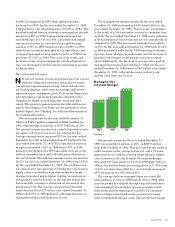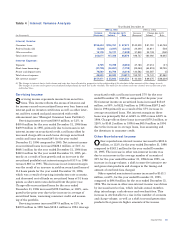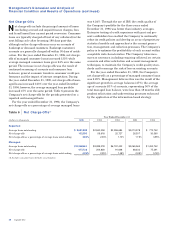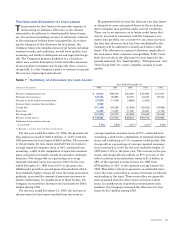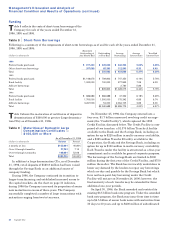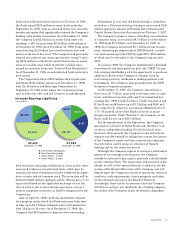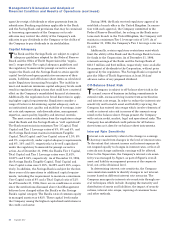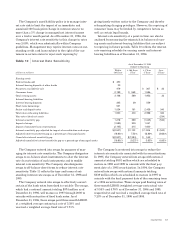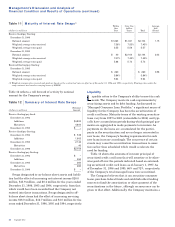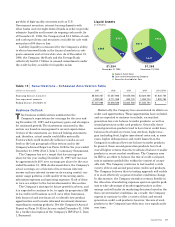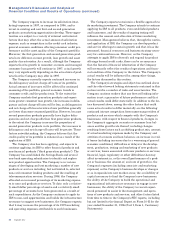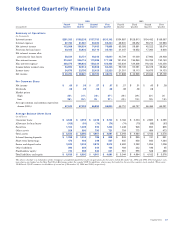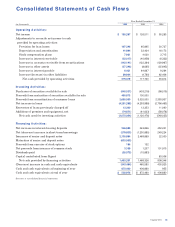Capital One 1996 Annual Report Download - page 35
Download and view the complete annual report
Please find page 35 of the 1996 Capital One annual report below. You can navigate through the pages in the report by either clicking on the pages listed below, or by using the keyword search tool below to find specific information within the annual report.
Table 10 Interest Rate Sensitivity
As of December 31,1996
Subject to Repricing
Within > 180 Days- > 1 Year- Over
(dollars in millions) 180 Days 1 Year 5 Years 5 Years
Earning assets
Federal funds sold $ 450
Interest-bearing deposits at other banks 30
Securities available for sale 479 $ 367 $ 32
Consumer loans 2,189 $ 569 1,586
Total earning assets 3,148 569 1,953 32
Interest-bearing liabilities
Interest-bearing deposits 345 39 559
Short-term borrowings 531
Senior and deposit notes 1,054 161 2,439 340
Total interest-bearing liabilities 1,930 200 2,998 340
Non-rate related net assets (234)
Interest sensitivity gap 1,218 369 (1,045) (542)
Impact of swaps (1,580) 539 1,041
Impact of consumer loan securitzations (2,145) 215 1,930
Interest sensitivity gap adjusted for impact of securitization and swaps $(2,507) $1,123 $ 1,926 $ (542)
Adjusted interest sensitivity gap as a percentage of managed assets (16.80)% 7.52)% 12.90)% (3.63)%
Cumulative interest sensitivity gap $(2,507) $(1,384) $ 542
Adjusted cumulative interest sensitivity gap as a percentage of managed assets (16.80)% (9.27)% 3.63)% 0.00)%
Capital One 33
The Company has entered into swaps to reduce the
interest rate sensitivity associated with its securitizations.
In 1995, the Company entered into swaps with notional
amounts totaling $591 million which are scheduled to
mature in 1998 and 1999 to coincide with the final pay-
ment date of a 1993 securitization. In 1994, the Company
entered into swaps with notional amounts totaling
$539 million which are scheduled to mature in 1997 to
coincide with the final payment date of the remaining term
of a 1994 securitization. These swaps paid floating rates of
three-month LIBOR (weighted average contractual rate
of 5.55% and 5.78% as of December 31, 1996 and 1995,
respectively) and received a weighted average fixed rate of
7.23% as of December 31, 1996 and 1995.
The Company entered into swaps for purposes of man-
aging its interest rate sensitivity. The Company designates
swaps to on-balance sheet instruments to alter the interest
rate characteristics of such instruments and to modify
interest rate sensitivity. The Company also designates
swaps to off-balance sheet items to reduce interest rate
sensitivity. Table 11 reflects the type and terms of out-
standing interest rate swaps as of December 31, 1996 and
1995.
The Company entered into swaps to effectively convert
certain of the bank notes from fixed to variable. The swaps,
which had a notional amount totaling $974 million as of
December 31, 1996, will mature in 1997 through 2000 to
coincide with maturities of fixed bank notes. As of
December 31, 1996, these swaps paid three-month LIBOR
at a weighted average contractual rate of 5.59% and
received a weighted average fixed rate of 7.71%.
The Company’s asset/liability policy is to manage inter-
est rate risk to limit the impact of an immediate and
sustained 100 basis point change in interest rates to no
more than a 5% change in managed net interest income
over a twelve month period. As of December 31, 1996, the
Company’s interest rate sensitivity to this change in rates
was 2.09%, which was substantially within Company
guidelines. Management may reprice interest rates on out-
standing credit card loans subject to the right of the cus-
tomers in certain states to reject such repricing by
giving timely written notice to the Company and thereby
relinquishing charging privileges. However, the repricing of
consumer loans may be limited by competitive factors as
well as certain legal bounds.
Interest rate sensitivity at a point in time can also be
analyzed by measuring the mismatch in balances of earn-
ing assets and interest-bearing liabilities that are subject
to repricing in future periods. Table 10 reflects the interest
rate repricing schedule for earning assets and interest-
bearing liabilities as of December 31, 1996.


